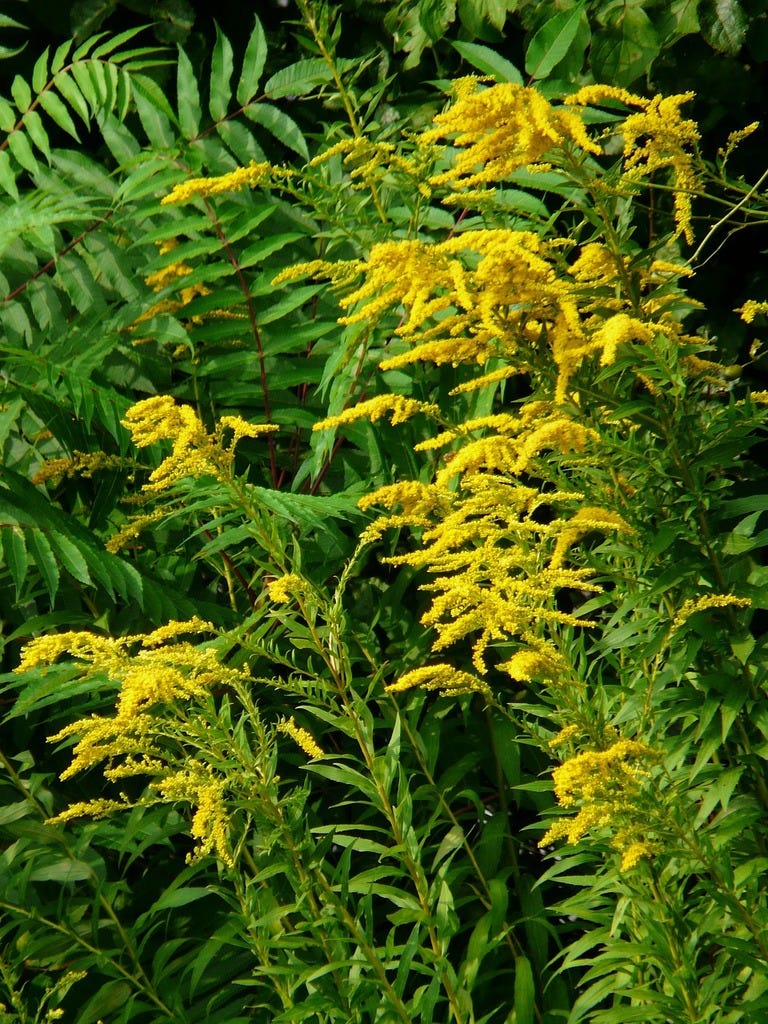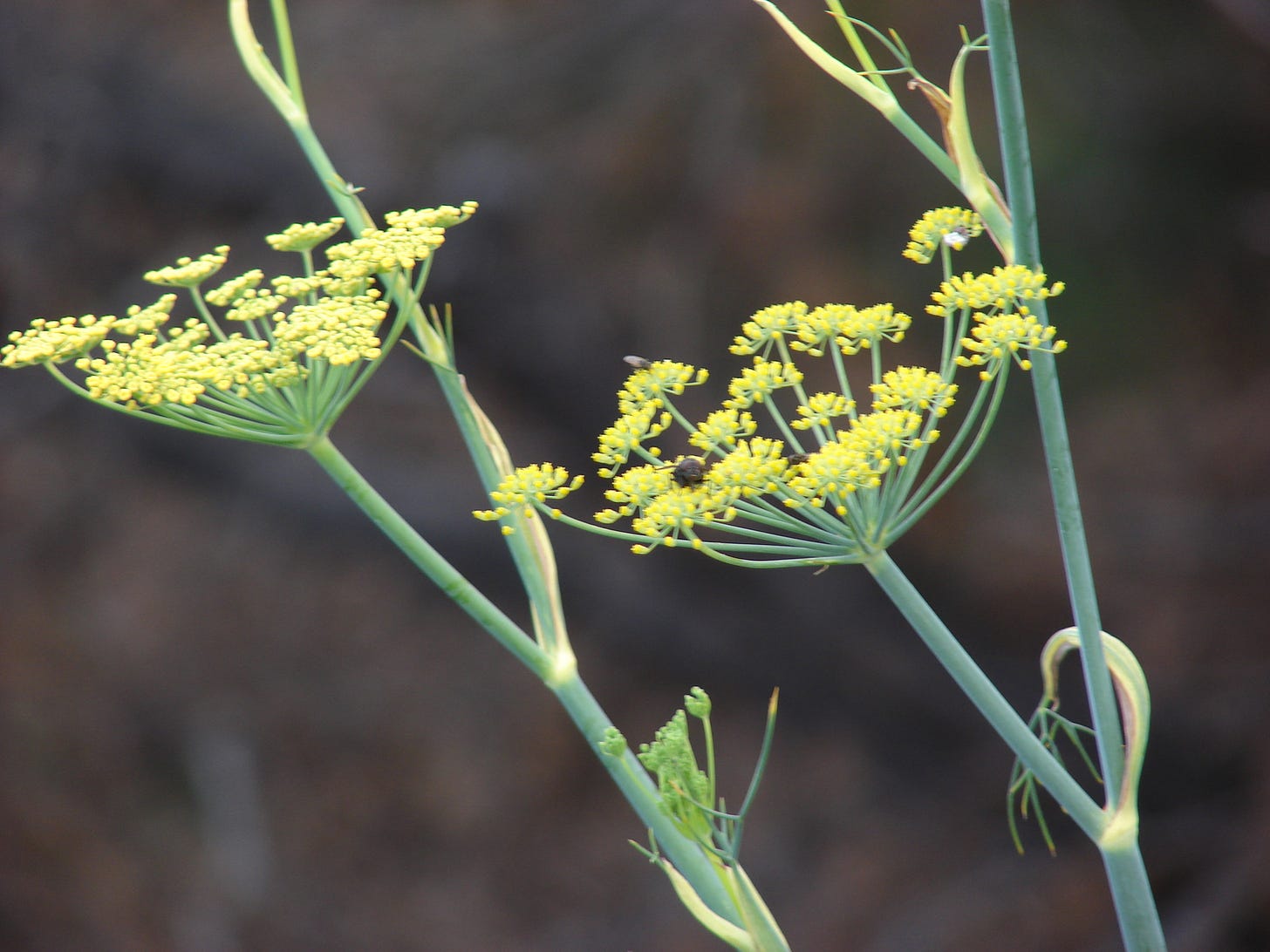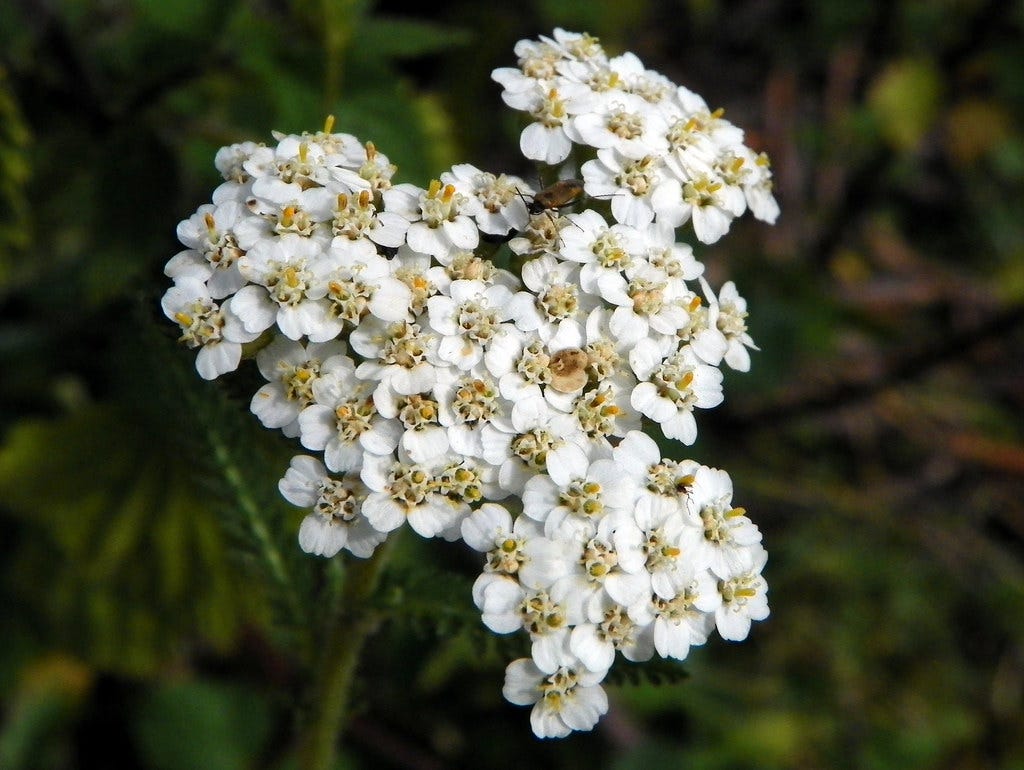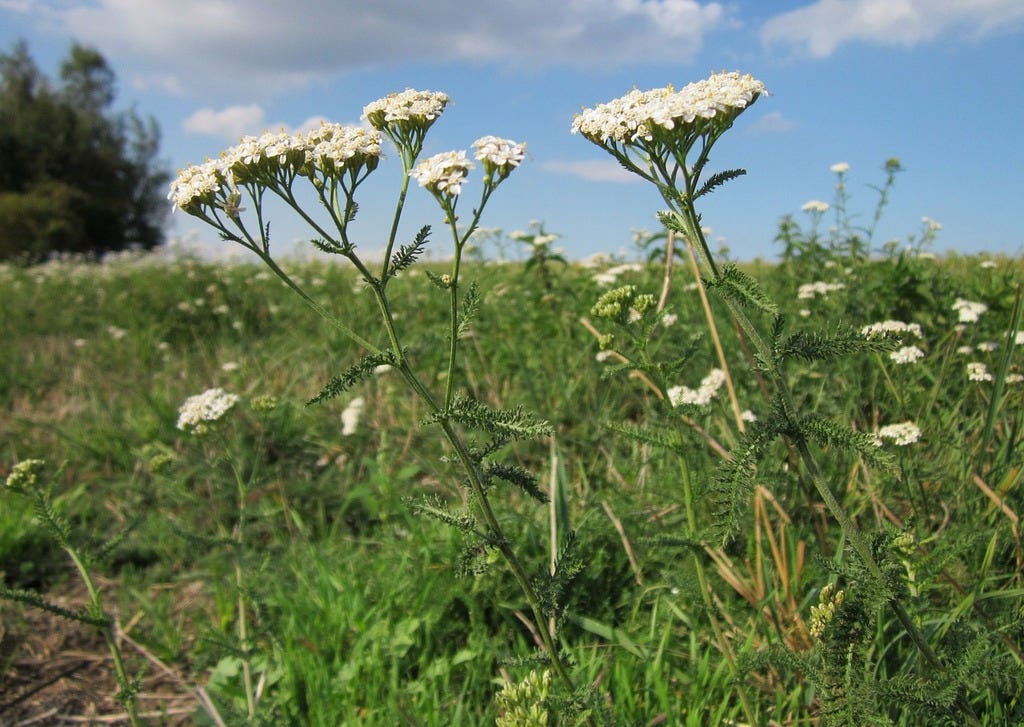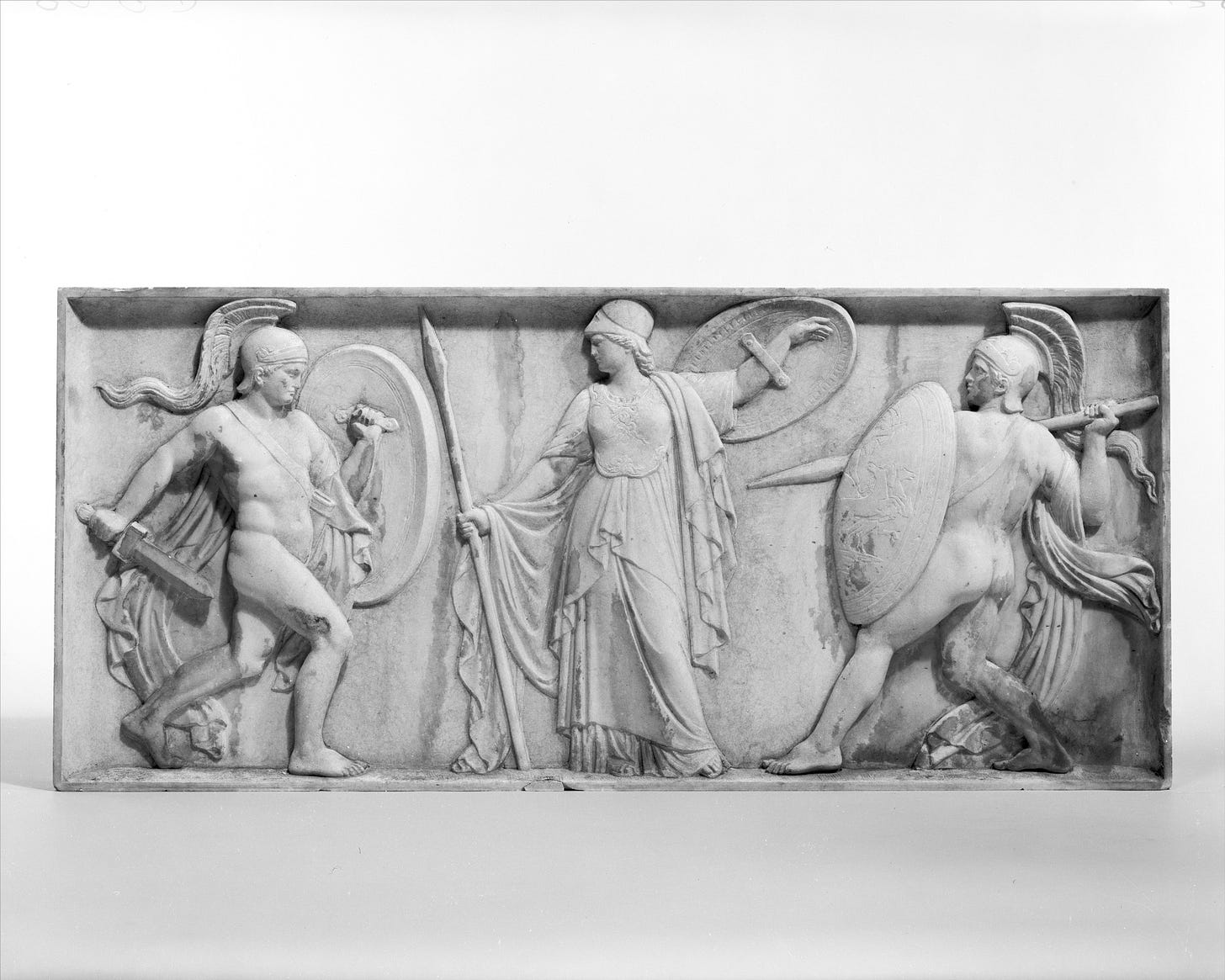ALSO KNOWN AS: thousand seal, sanguinary, old man’s pepper, woundwart, bloodwart, plumajillo, Achillea Millefolium
not goldenrod with its pyramidal inflorescence
or sweet fennel with its small separated yellow flowers
pink, red, white, or yellow flowers clustered - nearly bubbling they are so filled with tiny stamens of pollen.
soft and hardy stems
Alternate leaves bristled like soft pipe cleaners
Where the tension once was, where the chaos and destruction pause there is a the small bubble of love in the midst of tremendous pain. Yarrow goes to the heart of the war:
The horrible places of battle where the wounds are deepest, most immediate.
Yarrow always had a spiritual air around it. It never seemed like a simple plant, if I can make that distinction. I, frankly, didn’t know how to identify it for a long time. Many of the plants in my region were familiar to me. Yarrow was not so casually eaten like wood sorrel, black berries, raspberries, red caps, mint, and queen anne’s lace. Yarrow, was silent. For a long time yarrow was a tawny medicine I did not know the face of, only the name. And perhaps it has reason to be silent. It has treated some of the most grotesque wounds: those of the flesh.
Achillea Millefolium is named after Achilles, the strongest warrior in the Greek army. The warrior who was both fated, and in love. The warrior whose atrocities could not only have been dragging Hector’s body through the mud. No, Achilles, is destined to carry all of his glory, suffering, and evil of war, which is to say, a part of this world, even after death. In the end, no matter the famous yarrow baths he took, or the healing he gave to his fellow soldiers through yarrow’s touch, the plant could not save him.
The nativity of this plant is debated, but suffice it to say it is native to the northern hemisphere. It’s possible that there are two - twins: one in the Americas and one from Eurasia, from alpine to coastal regions. Yarrow doesn’t ask for much, frothing in the middle of a field or empty lot, resisting long periods of drought and lavishing in full sun.
Rather than the rounded wild carrot inflorescence, yarrow has a flat topped capitulum and slightly more robust composite flowers. Their blooms are just as strong as their namesake. Yarrow is some of the first to bloom in March and the last to bloom in October. A compound called matricine, is converted to azulene or chamazulene, two chemicals that are not present in the actual plant, during the steam distillation of yarrow. Azulene is a fragrant chemical seen also in invertebrates and mushrooms.Chamazulene is found in Chamomile and artemisia plants: also blue. Also aromatic.
Also soft all around. Thousand leaves, as exemplified in the name millefolium perhaps allude to the idea that the plurality of something makes it soft and produces an indescribable lightness. Yarrow congeals blood, which is why was the plant used for flesh wounds.
This is another Asteraceae. It is the largest plant family beside the orchid. “The family contributes tremendously to the diversity and thus the stability of arid woodland and shrubland ecosystems throughout the world.” The National Audubon Society Field Guide to Wildflowers of the Eastern Region settles. They are related to both lettuce and the dramatically beautiful artichoke.
How substantial the arms are, holding flowers that are equally hearty, even though they’re small.
It exists in so many places that yarrow has a deep cultural history in many parts of the world. And through the thousands of miles, from China to California and everywhere in between, yarrow feels like an anchor we carry with us in the face of change. “war [is] a metaphor for the universal clash of opposites that rules natural processes of change.” The Book of Symbols says about war. It was believed to conjure future loves if sewn into bed flannels or pillows. Yarrow sticks are a traditional form of throwing the I-Ching, the book of changes. Plants that were local to the divinor were believed to be more connected to the reader and thus make the readings more aligned. The Anishinaabeg believed yarrow scared away evil. Great, profound change, and also themes of protection surround this plant.
Maybe the tripinnate leaves are fuzzy caterpillars extending from the stalk or maybe they are the Plumajillo,a Spanish term from New Mexico and Colorado: the “little feather” lifting off in a radical hope to lift the earth like the wings of swans to a land where they might not be used in battle but exist in the dreams of lovers.
While yarrow is profoundly sacred, close the hearts of humans, it plays an essential role in the ecosystem. The Miner, digger, bumble, leafcutter, mason, and sweat bees, checkered beetle, and gossamer-winged butterfly are all drawn to yarrow.
myth for yarrow
There is a silence of the battlefield, a whirring current of what else could have been, a pleading silence that asks: what could possibly be next? The yarrow was given to us when we became mortal. They gave it to us because we would not stop fighting with each other, but knew we could heal. So we care for one another with yarrow, we carry yarrow through the changes we can not bear. The gods wanted to remind us that love exists, even in the bloodiest of places, even in the deepest wounds. They did not want us to stop loving even then.
It is a gift to the world as a soft reminder that courage is borne in the opening of the heart.
Forager Friendly!
The leaves, stems, and roots can be used to a range of ailments, from headaches, and burns. Haemostatic (assisting in the clotting of blood), stimulant, and promotes perspiration to break a fever; indigestion; and flu like symptoms.
Though bitter, it can be used as an herb.
Sources:
https://www.fs.usda.gov/wildflowers/plant-of-the-week/achillea_millefolium.shtml
https://www.almanac.com/plant/yarrow
https://wildfoodsandmedicines.com/yarrow/
https://www.minnesotawildflowers.info/flower/common-yarrow
https://www.texasnaturalsupply.com/Yarrow-Essential-Oil-p/yrrwg-eo.htm
https://www.rowanandsage.com/blog/2019/12/6/plant-profile-yarrow




